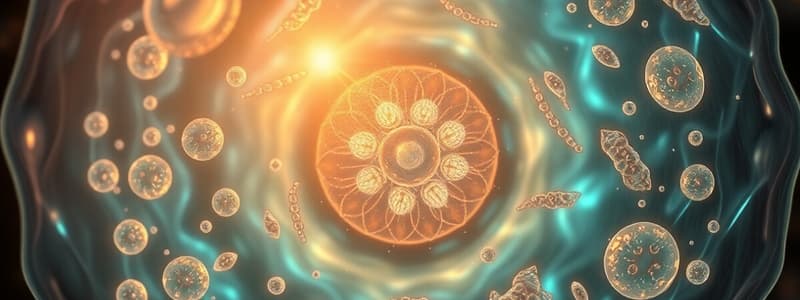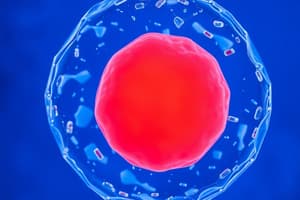Podcast
Questions and Answers
Which of the following is NOT a primary function of the plasma membrane?
Which of the following is NOT a primary function of the plasma membrane?
- Synthesizing proteins for the cell (correct)
- Maintaining cell shape and structure
- Facilitating cell signaling and communication
- Regulating the transport of substances into and out of the cell
Integral membrane proteins are characterized by their ability to be easily removed from the membrane without disrupting the lipid bilayer.
Integral membrane proteins are characterized by their ability to be easily removed from the membrane without disrupting the lipid bilayer.
False (B)
Briefly explain how the sodium/potassium pump contributes to maintaining the electrochemical gradient across the plasma membrane.
Briefly explain how the sodium/potassium pump contributes to maintaining the electrochemical gradient across the plasma membrane.
The sodium/potassium pump actively transports sodium ions out of the cell and potassium ions into the cell, both against their concentration gradients, using ATP. This generates an electrochemical gradient crucial for nerve impulse transmission and other cellular processes.
The nuclear envelope is a double-membrane structure punctuated by ______, which regulate the movement of molecules between the nucleus and cytoplasm.
The nuclear envelope is a double-membrane structure punctuated by ______, which regulate the movement of molecules between the nucleus and cytoplasm.
Match each cellular component with its primary function:
Match each cellular component with its primary function:
What is the primary role of actin filaments in cell motility?
What is the primary role of actin filaments in cell motility?
Microtubules are inherently stable structures and do not exhibit dynamic instability.
Microtubules are inherently stable structures and do not exhibit dynamic instability.
Explain how kinesins and dyneins contribute to intracellular transport.
Explain how kinesins and dyneins contribute to intracellular transport.
During mitosis, the ______ is formed by microtubules to separate sister chromatids.
During mitosis, the ______ is formed by microtubules to separate sister chromatids.
Which of the following is NOT a characteristic of intermediate filaments?
Which of the following is NOT a characteristic of intermediate filaments?
Collagen, a major component of the extracellular matrix, provides tensile strength to tissues.
Collagen, a major component of the extracellular matrix, provides tensile strength to tissues.
Describe the role of integrins in cell-matrix junctions.
Describe the role of integrins in cell-matrix junctions.
[Blank] adhesion molecules mediate selective cell-cell adhesion, playing a critical role tissue organization and development.
[Blank] adhesion molecules mediate selective cell-cell adhesion, playing a critical role tissue organization and development.
Which of the following factors contributes to the formation of lipid bilayers in aqueous solutions?
Which of the following factors contributes to the formation of lipid bilayers in aqueous solutions?
Which of the following is the mechanism by which vesicles dock and fuse with the correct target membrane?
Which of the following is the mechanism by which vesicles dock and fuse with the correct target membrane?
Lysosomes are primarily involved in protein synthesis.
Lysosomes are primarily involved in protein synthesis.
Explain the significance of plasma membrane domains.
Explain the significance of plasma membrane domains.
The experiments that discovered the location of nuclear localization signals involved ______ and observing their subsequent localization.
The experiments that discovered the location of nuclear localization signals involved ______ and observing their subsequent localization.
Match each descriptions to its corresponding type of epithelial cell junction.
Match each descriptions to its corresponding type of epithelial cell junction.
How does transport across the nuclear envelope regulate gene expression?
How does transport across the nuclear envelope regulate gene expression?
Flashcards
Lipid composition of plasma membranes?
Lipid composition of plasma membranes?
Lipid composition includes phospholipids, glycolipids, and cholesterol, affecting membrane fluidity and function.
Protein association with plasma membrane?
Protein association with plasma membrane?
Proteins associate as integral (embedded) or peripheral (surface-attached), performing various functions like transport and signaling.
Formation of lipid bilayers?
Formation of lipid bilayers?
Lipid bilayers form due to hydrophobic interactions of fatty acid tails and hydrophilic interactions of polar head groups with water.
Difference between integral & peripheral membrane proteins?
Difference between integral & peripheral membrane proteins?
Signup and view all the flashcards
Diffusion through lipid bilayer?
Diffusion through lipid bilayer?
Signup and view all the flashcards
Transport by carrier proteins?
Transport by carrier proteins?
Signup and view all the flashcards
Ion channels vs. carrier proteins?
Ion channels vs. carrier proteins?
Signup and view all the flashcards
Action of sodium/potassium pump?
Action of sodium/potassium pump?
Signup and view all the flashcards
Ion gradients and active transport?
Ion gradients and active transport?
Signup and view all the flashcards
Structure of nuclear envelope?
Structure of nuclear envelope?
Signup and view all the flashcards
Protein transport in/out of nucleus?
Protein transport in/out of nucleus?
Signup and view all the flashcards
Nuclear transport & gene expression?
Nuclear transport & gene expression?
Signup and view all the flashcards
Protein entry into ER?
Protein entry into ER?
Signup and view all the flashcards
Roles of smooth and rough ER?
Roles of smooth and rough ER?
Signup and view all the flashcards
Protein transport to Golgi?
Protein transport to Golgi?
Signup and view all the flashcards
Function of Golgi apparatus?
Function of Golgi apparatus?
Signup and view all the flashcards
Process of vesicular transport?
Process of vesicular transport?
Signup and view all the flashcards
Vesicle docking/fusion mechanism?
Vesicle docking/fusion mechanism?
Signup and view all the flashcards
Function of lysosomes?
Function of lysosomes?
Signup and view all the flashcards
Lysosome formation?
Lysosome formation?
Signup and view all the flashcards
Study Notes
Chapter 14: Plasma Membranes
- Plasma membranes consist of various lipids.
- Proteins associate with the plasma membrane in different ways.
- Plasma membrane domains have specific functions because of their unique composition.
- Hydrophobic and hydrophilic interactions drive lipid bilayer formation.
- Integral membrane proteins are embedded within the lipid bilayer, whereas peripheral membrane proteins are associated with the membrane surface.
- Molecules that can diffuse through a lipid bilayer differ from those that require transporters.
- Transporters, such as carrier proteins, move small molecules across the membrane.
- Ion channels differ from carrier proteins in their transport mechanism.
- The sodium/potassium pump uses energy to transport ions against their concentration gradients.
- Ion gradients across the plasma membrane can power active transport processes.
Chapter 10: Nucleus
- The nuclear envelope and nuclear pore complex (NPC) mediate transport into and out of the nucleus.
- Proteins are transported into and out of the nucleus through the NPC.
- Transport across the nuclear envelope regulates gene expression.
- Nuclear localization signals (NLS) are sequences that target proteins for import into the nucleus.
Chapter 11: Protein Sorting and Transport
- Mechanisms mediate the entry and sorting of proteins into the endoplasmic reticulum (ER).
- Smooth ER and rough ER have distinct roles, including lipid synthesis and protein synthesis/modification, respectively.
- Transport to and retrieval from the Golgi apparatus are essential for its function.
- The structure of the Golgi apparatus relates closely to its function in processing and packaging proteins.
- Proteins are exported from the Golgi via specific routes.
- Vesicular transport involves vesicles budding off from one membrane and fusing with another.
- Vesicles dock and fuse with the correct target membrane through specific mechanisms.
- Lysosomes break down cellular waste and debris.
- Lysosomes are formed through a specific biogenesis process.
Chapter 13: Cytoskeleton
- Actin filaments exhibit dynamic behavior, and actin-binding proteins regulate their assembly and function.
- Actin filaments are organized in specific ways beneath the plasma membrane.
- Remodeling of actin filaments underlies cell motility.
- Microtubules display dynamic instability in their structure.
- Microtubule growth is initiated within cells at microtubule organizing centers.
- Microtubule-associated proteins (MAPs) regulate the organization of microtubules.
- Kinesins and dyneins are motor proteins with distinct properties.
- Organelles and other cargo are transported on microtubules via motor proteins.
- The mitotic spindle is structured with microtubules.
- Intermediate filament proteins are classified into different types.
- Intermediate filaments have a characteristic structure.
- Intermediate filaments within cells determine cell structure and behavior.
Chapter 15: Cell Interactions
- Collagen is a major component of the extracellular matrix with distinct structural properties.
- Integrins mediate cell-matrix junctions and cell signaling.
- Selective cell-cell adhesion involves different types of adhesion molecules.
- Epithelial cell junctions can be categorized based on their structure and function.
Studying That Suits You
Use AI to generate personalized quizzes and flashcards to suit your learning preferences.




